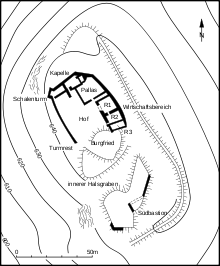Schwarzenburg (Breisgau)
| Schwarzenburg(Waldkirch) | |
|---|---|
 The ruins of the Schwarzenburg with view towards Waldkirch | |
| Highest point | |
| Elevation | 656.2 m (2,153 ft) |
| Coordinates | 48°04′12.62″N 7°57′47.45″E / 48.0701722°N 7.9631806°ECoordinates: 48°04′12.62″N 7°57′47.45″E / 48.0701722°N 7.9631806°E |
| Naming | |
| Translation | Black castle (German) |
| Geography | |
 Schwarzenburg(Waldkirch) The location within Baden-Württemberg | |
| Location | Baden-Württemberg, Germany |
| Parent range | Black Forest |

The Schwarzenburg (Black Castle), historically called Schwarzenberg (Black Mountain), is a fortified castle near Waldkirch in the district Emmendingen in the southwest of Baden-Württemberg in southern Germany.
Geographical location
Along with the Kastelburg the less known Schwarzenburg is the second castle ruin owned by the town Waldkirch. The ruins of the former hill castle, 656.2 m (2153 ft) above sea level on the top of the Schwarzenberg (Black Mountain), a spur of the Kandel has already decayed to such an extent that only a few foundation walls are visible.
Purpose of the castle foundation
It was probably created as an escape and protection castle, possibly based on power political considerations of the Schwarzenbergs. Such a castle on a vantage point visible from far away in the Rhine Valley was an obvious proof of their status as free noblemen subordinate in rank only to the Kaiser.
Ownership of the castle
In sharp contrast to Waldkirch and the Kastelburg which was founded later the Schwarzburg was no Further Austrian fief, but the personal property of the Schwarzenberg's until they died out in the mid-15th century.
History
The Schwarzenburg was built around 1120 by the patrons of the monastery St. Margaret in Waldkirch under Conrad Waldkilcha who after 1120 called himself Conrad of Suarzinberg and thus became the founder of the noble family of Schwarzenberg.
With Konrad the male branch of the Conradiner of Waldkirch died out. In 1213 their possessions were transferred to Konrad's sister Adelheid, wife of Walter I of Eschenbach-Schnabelburg. In 1270 Johann, a descendant of Adelheid who came with his nephew William from Switzerland, took over the rule and called himself Johann I von Schwarzenberg. On 8 August 1300 Johann and Wilhelm von Schwarzenberg granted Waldkirch the town privileges. In 1315 the territory was divided: Johann took over the Kastelburg and Wilhelm remained on the Schwarzenburg.
The Schwarzenberg family line died out in 1347 with landlord Ulrich II of Schwarzenberg. He was succeeded by Johann III. of the Kastelberg line. This led to the reunification of the two lines.
After the death of Hans Werner von Schwarzenberg in 1459 his son-in-law Heinrich von Rechenberg zu Hohenrechberg inherited the estate and the office of bailiff.
1503 Martin von Rechenberg succeeded his late father Henry; in turn he was succeeded in 1540 by his son Hans Ludwig von Rechberg.
After the death of Hans Ludwig in 1542 Sebastian von Ehingen acquired the goods. During the wedding ceremony of his daughter in 1559 he was stabbed by his son.
Thereupon the rule of Schwarzenberg was transferred to Hans Raphael Reischach as a fief in 1560.
1567 Ferdinand II, Archduke of Austria took over the debt-ridden territory. He ordered to demolish and remove the dilapidated Schwarzenburg castle in 1578. This order was, however, not complied with.
An inspection in 1583 by the Further Austrian government agency of Ensisheim led to the findings: Strong decay.
In accordance with the report of an annalist of the Margarethenstift Waldkirch of 1590 not much was left of the roof structure and the walls had collapsed. The ruin was eventually used as a quarry.
Beginning in 1975 the castle was consecutively analyzed and restored and since 1980 it is accessible.
In 1995, the town Waldkirch attached a sign with the historical data of the castle next to the ruins.
Further reading
- Alfons Zettler, Thomas Zotz: Die Burgen im mittelalterlichen Breisgau, I. Nördlicher Teil: Halbband L-Z (the castles in the medieval Breisgau, I. northern part: half volume L-Z). Jan Thorbecke Verlag, Ostfildern 2006, ISBN 978-3-7995-7365-8, pages 470-496.
- Andreas Hassis Berner: Die Schwarzenburg bei Waldkirch (the Black castle near Waldkirch), pages 121-147 in: Beiträge zur Geschichte der Stadt Waldkirch (articles on the history of Waldkirch) volume 6, 700 Jahre Stadtrecht Waldkirch 1300 - 2000 (700 years town privileges Waldkirch 1300 - 2000). Published by the City of Waldkirch, July 2000.
| Wikimedia Commons has media related to Burg Schwarzenberg, Waldkirch im Breisgau. |
